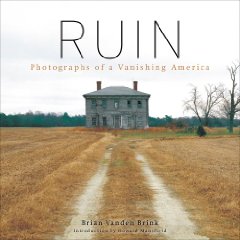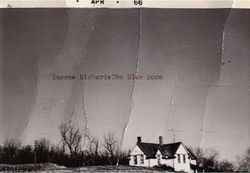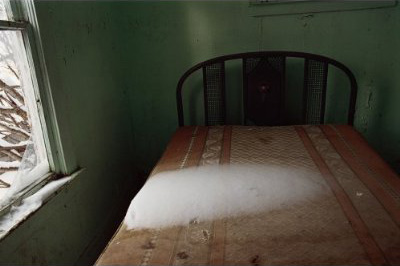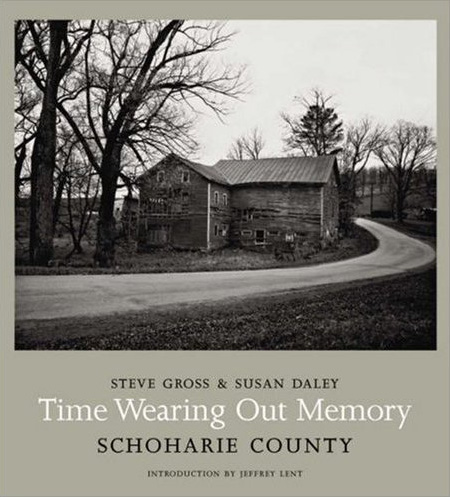By Geoff Wittig
The pictorial representation of ruins and abandoned structures has a long and honorable history in art. Europe and the near East are chock full of such things, and Renaissance painters commonly included Roman ruins in their landscapes to add a bit of class to their work. Here in the States things are a little different; we don't have grand 2,000 year old stone palaces or castles in genteel decline. Rotting farmsteads and decaying warehouses are more like it. Yet they still have something to offer the discerning eye. These old structures surely say more about the soul of a place than our contemporary architectural wasteland of strip malls and fast food joints. There are a number of photo books currently available that address the topic, and a few more that have recently gone out of print that might still be available.
-
 Ruin: Photographs of a Vanishing America
Ruin: Photographs of a Vanishing America
Brian Vanden Brink
Hardcover: 144 pages
Down East Books (June 25, 2009)
12 x 12 x 0.7 inches
U.K. link
Brian Vanden Brink is an architectural photographer based in Camden, Maine who pays the bills with the usual immaculate portraits of grand homes and commercial buildings. He also took photographs for the Historic American Engineering Record and the Historic American Building Survey, noble attempts to preserve something of this country's abbreviated architectural record. Between assignments and commercial jobs he also captured more personal images of derelict structures around the country.
Ruin is an interesting pastiche. All images are large format film capture, the majority in color but some black and white as well. There are a few well-known subjects such as the Windsor Ruins and "Mammy's Cupboard," both in Mississippi, and a handful of industrial structures or bridges. There are also some chilling photos of abandoned Cold War nuclear weapon storage bunkers; but the bulk of the subjects are nameless wooden farmhouses and quotidian shops. Most of Vanden Brink's black and white images have a delicate tonal scale. The color photographs likewise mostly display a restrained pastel palette and soft illumination. The absence of the neon Velvia æsthetic and "golden hour" lighting is refreshing. The little details in his photos are endlessly appealing; the fallen chimney bricks on the roof of a Maine home are magnetic to the eye.
The design of the book is spare. Vanden Brink's brief preface nicely explains his fascination with these bereft structures. Howard Mansfield's introduction frankly doesn't add much to the book. The limited text is carefully set in an attractive digital typeface. The photographs, many of them full bleed, are beautifully reproduced. A handful are defaced by printing them across the gutter, yet they don't seem to suffer too much for it.
If you have a soft spot in your heart for derelict buildings, you'll love this book. Vanden Brink obviously knows his craft.
-
 The Blue Room
The Blue Room
Eugene Richards
Hardcover: 168 pages
Phaidon Press (December 3, 2008)
16.1 x 11.1 x 0.9 inches
U.K. link
Eugene Richards is widely admired for his pungent black and white photojournalism, addressing subjects ranging from the cocaine epidemic to urban emergency rooms to post-9/11 New York. The Blue Room is very different from his usual work; it's shot in color, without a single human being visible in any frame. Richards indirectly addresses the collapse of America's rural family farm culture by examining the abandoned remnants. His visual æsthetic is poles apart from Vanden Brink's; grainy 35 mm frames, skewed horizons, close-ups of abandoned shoes and the corpses of insects lined up on a window ledge. The decay is a bit overwhelming in many images, yet others are pure visual poetry. Windblown snow from a broken window drifts across a bed; abandoned barns and windmill are glimpsed through a grime-encrusted screen. Probably not a book to peruse if you're already depressed, but Richards has a remarkable eye.
The book is physically large, the color images all printed on the right hand leaf full size with a small margin. Many are darkish and moody, and they tend toward a subdued color palette with reds standing out, which makes me think "Kodachrome." Text is limited to a series of brief vignettes, some hinting at Richards' contact with previous inhabitants of the homes, others "verbal pictures" of his first impression of a decaying building. The text is set in an imitation "typewriter" font, which I find a distracting affectation, but it's the author's prerogative; Richards designed the book himself.
-
Time Wearing Out Memory: Schoharie County
Steve Gross and Susan Daley
Hardcover: 128 pages
W.W. Norton & Co. (May 17, 2008)
11.2 x 10.4 x 0.8 inches
U.K. link
Steve Gross and Susan Daley are photographers living in New York City who bought a "country home" in Schoharie County, three hours north, in 1987. Over the course of twenty years they took traditional large format black and white photographs of the rural vernacular architecture. A handful are still actively used, but most are abandoned, and more than a few have since been demolished. Farmhouses, barns, general stores, churches and meeting halls are all given the same careful attention. The resulting images are classic "zone system" products; every tone is carefully considered and placed for effect, the compositions carefully balanced, the skies often dramatic. The result is pictorially beautiful, even if it seems a bit odd to give an abandoned barn the "full Ansel Adams." The reproductions are excellent, duotones conveying good shadow detail and smooth tones.
If these books inspire you to go out and photograph a few sagging relics in your own backyard before they're gone forever, then they've done their job.
• • •
Two more books on the subject are worth looking for, though they're out of print. You may be able to find them at remaindered prices.
Ghosts in the Wilderness: Abandoned America
Tony and Eva Worobiec
Hardcover: 176 pages
Artist's and Photographers' Press Ltd. (October 28, 2003)
14.4 x 11.3 x 0.8 inches
This is a beautifully printed collection of essays and photographs by Tony and Eva Worobiec, a husband and wife team based in England. They're probably better known for their instructional books and articles, many on the subject of toning of black and white prints, both darkroom and digital. The couple made five separate journeys and spent many months wandering the American prairie states, photographing the ghost towns and abandoned farms. It won't be to everyone's taste; the images cover a wide range of styles, from straight color and black and white to heavily manipulated toned and hand-colored images. Some of the photographs look simply odd to my eye, yet others are striking, and many are quietly beautiful. the essays are thoughtful meditations on the rise and fall of the prairie farming culture at the hands of unscrupulous railroad promoters and a hostile climate, and the leathery toughness of those who have endured all the same.
Abandoned America
Steve Gottlieb
Hardcover: 175 pages
Sleeping Bear Press (December 15, 2002)
11 x 10.4 x 0.7 inches
Steve Gottlieb prospered as a lawyer, then launched a second career as a photographer. His photographs of ruined buidlings, rusting vehicles and decaying machinery are incongruously rendered in bright, Velvia style colors that make them seem almost festive. Ruins-as-cotton-candy is an unusual æsthetic choice, but it seems to work for many of the subjects.
Geoff
Featured Comment by Ken Tanaka: "A wonderful collection of ruins books, Geoff. I'm going to make it a point to get a peek at at least two of these. May I add one other book to the collection? Vanishing America: The End of Main Street Diners, Drive-Ins, Donut Shops, and Other Everyday Monuments
by Michael Eastman and William Gass (pub: Rizzoli) is a work very much kindred to these books."
Geoff replies: Ken, Michael Eastman's Vanishing America is indeed another worthy effort, though a bit different from the other books here. Eastman concentrates on the tacky charm of diners, donut joints, storefronts, old theaters and bowling alleys, mostly using a wide-angle perspective. His images are all heavily Photoshop'd into a uniform 1950s æsthetic of bright pastel colors and crisp edges. It's an acquired taste, but the artistic consistency of it is appealing. Sort of the "anti-Plowden" look.
Featured Comment by Joe Reifer: "Thanks for the list on a topic that's dear to my heart. I'd add Camilo José Vergara's book American Ruins
to the list if I may."
Featured Comment by Michael MacLean: "I am glad you included Ghosts in the Wilderness: Abandoned America by Tony and Eva Worobiec. I was fortunate to attend a lecture by Tony at the time of the book's publication and saw a number of these images as prints. It really did show that he is a master of the craft. Personally, I like the variation in the work and was very much inspired by his toned and hand-coloured images."
Featured Comment by Ludovic: "I saw 'The Blue Room' exhibited this summer at Les Rencontres Photographiques d'Arles, and I was blown over, completely. I cannot recommend enough that people get this."




